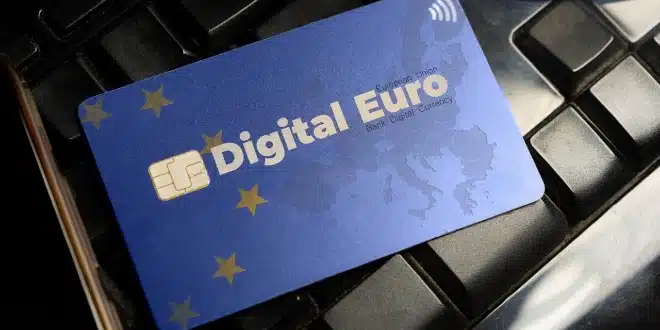The European Union is pushing forward with its digital euro project, with officials now exploring the use of public blockchains such as Ethereum and Solana as potential platforms. The move reflects growing urgency to secure the euro’s role in the digital economy as stablecoins and regulatory advances in the United States threaten to reinforce the dollar’s dominance.
Why the EU is Rushing Toward a Digital Euro
According to a Financial Times report on August 22, EU policymakers are increasingly concerned that new U.S. legislation—particularly the GENIUS Act, which provides clearer rules for stablecoins—could strengthen the dollar’s position in the global digital payments ecosystem. Currently, the $288 billion stablecoin market is heavily skewed toward dollar-pegged tokens such as USDT and USDC, leaving the euro with limited influence.
The European Central Bank (ECB) has been studying the idea of a digital euro for years, but the prospect of falling behind in the global shift toward digital currencies has accelerated the timeline. Officials argue that a euro-backed digital currency is essential to keep the currency competitive and to provide Europeans with a secure alternative to private stablecoins.
Piero Cipollone, a member of the ECB executive board, emphasized earlier this year that while cash will remain available, it is no longer sufficient to meet modern payment needs. “Cash cannot do the job alone in the digital age,” he said, noting that a central bank digital currency (CBDC) would preserve access to public money and keep the euro relevant as economies digitize.
Public Blockchains in the Spotlight
Until recently, plans for a digital euro had focused on private, ECB-controlled blockchain systems, which would allow regulators to directly oversee wallets and transactions. However, officials are now considering Ethereum and Solana as possible platforms, believing that integrating with established public blockchains could boost adoption and circulation, especially beyond Europe.
This shift would mirror global trends: public blockchain ecosystems already power much of the world’s stablecoin infrastructure, which has proven capable of handling billions in daily transactions. Leveraging such networks could help the EU avoid reinventing the wheel while still maintaining regulatory oversight.
Resistance from Banks and Industry Uncertainty
Despite the momentum, the digital euro project faces resistance. European banks have voiced skepticism, warning that a central-bank-backed digital currency could undermine their business models by diverting customers away from traditional savings and payments services. Banks fear that widespread adoption of the digital euro might reduce their role as intermediaries in financial transactions.
The rollout timeline also remains uncertain. While October 2025 has been floated as a possible launch date, progress depends on securing legislative approval and finalizing regulatory frameworks. Recent developments suggest the project could be fast-tracked, though much will hinge on how the EU balances innovation with financial stability.
What This Means for the Future
If adopted on a public blockchain, the digital euro could mark a dramatic shift in how central banks interact with global financial infrastructure. It would also set the euro apart from other central bank digital currencies (CBDCs), most of which are being developed on private, closed networks.
For citizens and businesses, a digital euro could mean faster cross-border payments, greater access to digital public money, and a stronger alternative to dollar-pegged stablecoins. For policymakers, however, the challenge lies in ensuring trust, security, and adoption while navigating resistance from Europe’s banking sector.
Bottom Line: The EU’s decision to consider Ethereum and Solana for the digital euro reflects both urgency and pragmatism. While the dollar currently dominates the digital payments world, the EU is positioning itself to compete—and potentially reshape the balance of global finance.


